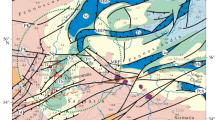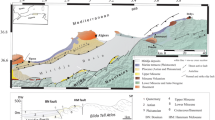Abstract
The results of the latest research on active faults in Southern Dagestan, in the area of Derbent, using the paleoseismological and archeoseismological methods are highlighted. The zone of seismogenerating fault—the Derbent segment of the regional tectonic boundary between the mountain structure of the Greater Caucasus and the North Caucasian foredeep—is revealed. The last seismotectonic slip along the fault due to a strong earthquake led to the displacement of the early medieval city wall of Derbent. The magnitude of this event was M ≈ 7, and, therefore, the seismic shaking intensity was I0 ≥ IX. This seismic event occurred, most likely, in the 10th century AD.
Similar content being viewed by others
Avoid common mistakes on your manuscript.
The territory of Dagestan is one of the most seismoactive regions of the Caucasus. For instance, in one area within Primorskii Dagestan alone, namely, the city of Derbent, ten earthquakes with intensities I = V–VI and one event with I = VII in 1913 were reported during the 20th century [1].
The standard problems to be solved when carrying out detailed mapping of seismic hazards are those about the positions of seismic generating structures, their seismic potential, and the recurrence intervals of strong earthquakes. Remarkably, these problems cannot always be solved correctly using seismological catalogs alone due to (i) the incompleteness of the pre-instrumental seismic record in these catalogs and (ii) the quite long recurrence period of strong earthquakes, up to hundreds and thousands of years. These gaps can be filled using the methods of paleoseismology and archeoseismology. Studies of seismogenic deformations from independent information sources (traces remained in the topography and recent sediments, and also damage to archeological sites and historical monuments) make it possible to extend the seismic “chronicle” for hundreds and thousands of years and accurately locate the seismic sources of strong earthquakes. Such an integrated approach is actively developing in the world and has been successfully applied during recent studies in the Crimea (see [2] and others).
The most indisputable and informative case is when the source of a strong historical earthquake ruptures to the surface with the displacement of ancient building constructions (see [4–6] and others). Based on the magnitude and direction of the displacement of building elements (for example, city walls or aqueducts), the slip kinematics at the source can be determined and the parameters of a historical seismic event can be calculated. The time of the event is determined by the age of archaeological artifacts and the data for determining the absolute age.
In 2018, we conducted paleoseismological and archeoseismological investigations in the area of the ancient city of Derbent. At present, the remains of constructions of different ages can be observed there; the first constructions here were erected in the late 560s AD, during the reign of the most powerful Iranian shah from the Sasanian dynasty, namely, Khosrow I Anushirvan (531–579) [3].
In the area of Derbent, we revealed the zone of a seismogenerating fault extending along the base of the Dzhalgan Range (Fig. 1). This zone is a segment of the regional tectonic boundary between the mountain structure of the Greater Caucasus and the Cis-Caspian Depression. The Derbent segment is expressed in the topography by a lithologic–tectonic scarp up to 100 m high, along which a section of Late Miocene carbonate deposits is traced; these deposits are folded into a near-fault anticlinal fold cut by a system of listric overthrust reverse faults, along which the layer of solid limestone underwent boudinage and triple occurrence in the section (Fig. 2). The internal structure of the fault zone is conformable to the surface relief of the scarp. At the scarp base, a gentle thrust is exposed, showing a steeper westward dip (up to 20°) with depth. In the Late Holocene proluvial-slope sediments, the deformation appears in the form of a wide (up to 50 m) zone of flexural-folded deformations. It can be thought that intensive Late Holocene compression in the frontal part of the thrust became pulsed, as is indicated by the buried paleosoil horizons. The sharp right-lateral bends of the valleys of temporary streams along the base of the scarp in the NW-oriented portions indicate the right-lateral shearing component of displacements.
Above is a plan of the preserved portions of the medieval fortress wall of Derbent with the location of the Derbent active fault and the area of detailed study of the displaced wall (rectangle). Below is a general map of the Derbent area with the location of the active faults traced: Derbent (D) and Primorskii (P). Line A–B is the position of the section shown in Fig. 2.
Schematic geological section of the Derbent fault zone along line A–B (see the profile position in Fig. 1). Red lines denote fractures. Figures in circles: 1, massive and thick-layer shell limestone (Late Miocene, Upper Sarmatian); 2, thin interbedding of clays, siltstones, limestones, and sandstones (Late Miocene, Middle Sarmatian); 3, thin interbedding of limestones, sandstones, and siltstones (Late Miocene, Middle Sarmatian); 4, clays; 5, loess-like sandy loams with lenses and interbeds of coarse clastic proluvium (Late Holocene); 6, colluvial–landslide deposits.
The latest slip along the NW-oriented fault led to the displacement of the northern wall of Derbent city. The fracture is traced in the Late Miocene rocks in a dry valley 170 m to the northwest of the wall. As a result of this slip, the wall, built with the characteristic Sasanian masonry (late 560s AD), was broken and shifted in the horizontal direction (Fig. 3). Judging by the wall’s southern face, the horizontal displacement was 1.4 m (right-lateral strike-slip) (Fig. 4a). However, judging by the displacement of the facing stone blocks on the northern wall face, the displacement was 0.9 m (Fig. 4b). The broken wall on both sides of the fault crept and tilted to the southeast at an angle of up to 74°. To hold this highly tilted position, a buttressed wall was erected in the late medieval period (Fig. 4a).
The southern face of the northern defensive wall of Derbent broken by the seismotectonic fracture. Figures in circles: 1, masonry of the Sasanian period, 6th century; 2, Seljuk masonry of the 11th–12th centuries; 3, masonry of the late Middle Ages, 16th–18th centuries or early 19th century; 4, modern restoration masonry. The plus sign marks the fault wing extended to the south, and the minus sign denotes the fault wing shifted to the north. View to the north.
Displacement of the northern defensive wall of Derbent along the seismotectonic fracture: (a) view of the northwestern part, on the southern face of the northern defensive wall of Derbent broken along the fault by 1.4 m; (b) displacement of the wall by 0.9 m. A considerable eastward tilt of the eastern part of the wall is visible, as well as an opening in the masonry of the Sasanian period. View to the southeast.
The new wall was built over the fault zone and upon the ruins of the Sasanian masonry in the Seljuk period (11th–12th centuries). The earthquake that displaced the wall occurred before the building of this new wall. It is possible that this seismic event occurred at the turn of the Arabian (8th–10th centuries) and Seljuk periods (we have not found any traces of repair referring to the Arabian time). We may have found one of the seismic sources that ruptured to the surface in the 10th century. There is some historical evidence interpreted as the record of two earthquakes of the 10th century, namely, the one of 918 AD with M = 6.1 (I0 = VIII), which was accompanied by “…the subsidence of the coast with the fortress wall of Derbent,” and the one of 957 AD with M = 5.5 (I0 = VII), when “…the Caspian waters were shifted by 300 cubits” [1]. It is also possible that we are dealing with the source of some unknown earthquake of the 11th or 12th century, for which no written information is available.
Based on the investigations conducted, it can be concluded that we have found the seismic source (epicentral zone) of a strong medieval earthquake that hit the very city of Derbent and its environs. The magnitude of this event was M ≈ 7, and, therefore, its seismic shaking intensity was I0 ≥ IX. The age of this seismic event is, most likely, the 10th century, but it may be even as young as the 11th–12th centuries. In any case, this age needs to be clarified.
REFERENCES
Earthquakes in Dagestan: General Catalogue. Macroseismic and Instrumental Data on Earthquakes for the Period from VII AD up to 2005 Year, Ed. by R. A. Levkovich (Epokha, Makhachkala, 2007) [in Russian].
A. N. Ovsyuchenko, A. M. Korzhenkov, A. S. Larkov, A. V. Marakhanov, and E. A. Rogozhin, Dokl. Earth Sci. 472 (1), 53–57 (2017).
M. Gadjiev, Iran Caucasus 12 (1), 1–15 (2008).
Y. Klinger, J. P. Avouac, L. Dorbath, N. Abou Karaki, and N. Tisnerat, Geophys. J. Int. 142 (3), 769–782 (2000).
A. M. Korjenkov, J. R. Arrowsmith, C. Crosby, E. Mamyrov, L. A. Orlova, I. E. Povolotskaya, and K. Tabaldiev, J. Seismol., No. 10, 431–442 (2006).
M. Rukieh, V. G. Trifonov, A. E. Dodonov, H. Minini, O. Ammar, T. P. Ivanova, T. Zaza, A. Yusef, M. Al-Shara, and Y. Jobaili, J. Geodyn. 40, 235–256 (2005).
Funding
This work was supported by the Russian Foundation for Basic Research, project no. 18–55–06007 Az_a, and was conducted within the framework of a State Assignment of the Schmidt Institute of Physics of the Earth, Russian Academy of Sciences.
Author information
Authors and Affiliations
Corresponding author
Additional information
Translated by N. Astafiev
Rights and permissions
About this article
Cite this article
Ovsyuchenko, A.N., Korzhenkov, A.M., Gadjiev, M.S. et al. Seismotectonic Deformation of the Early Medieval Fortress Wall of Derbent (Dagestan). Dokl. Earth Sc. 493, 535–538 (2020). https://doi.org/10.1134/S1028334X20070132
Received:
Revised:
Accepted:
Published:
Issue Date:
DOI: https://doi.org/10.1134/S1028334X20070132








